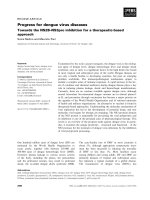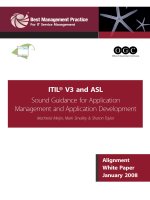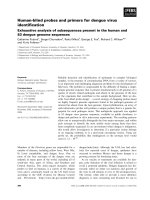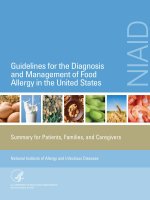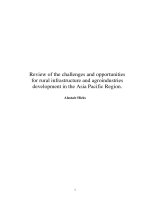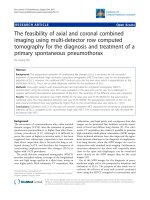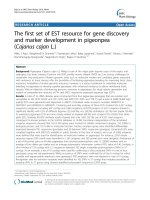Establishing improved platforms for dengue diagnosis and hybridoma development using dengue virus envelope domain III antigen a
Bạn đang xem bản rút gọn của tài liệu. Xem và tải ngay bản đầy đủ của tài liệu tại đây (8.11 MB, 308 trang )
ESTABLISHING IMPROVED PLATFORMS FOR
DENGUE DIAGNOSIS AND HYBRIDOMA DEVELOPMENT
USING DENGUE ENVELOPE DOMAIN III ANTIGEN
MELVIN TAN LIK CHERN
NATIONAL UNIVERSITY OF SINGAPORE
2010
Melvin Tan Lik Chern
B.Sc. (Hons), Monash University, Australia
A THESIS SUBMITTED FOR
THE DEGREE OF DOCTOR OF PHILOSOPHY
DEPARTMENT OF MICROBIOLOGY
YONG LOO LIN SCHOOL OF MEDICINE
NATIONAL UNIVERSITY OF SINGAPORE
2010
ESTABLISHING IMPROVED PLATFORMS FOR
DENGUE DIAGNOSIS AND HYBRIDOMA DEVELOPMENT
USING DENGUE ENVELOPE DOMAIN III ANTIGEN
i
PUBLICATIONS AND PRESENTATIONS GENERATED DURING
THE COURSE OF STUDY
Publications:
Tan, L.C.M., Chua, A.J.S., Goh, L.S.L., Pua, S.M., Cheong, Y.K. and Ng,
M.L. (2010). A membrane chromatography method for the rapid purification
of recombinant flavivirus proteins. Protein Expr Purif 74:129-37.
- Provided at the back of thesis.
Tan, L.C.M. & Ng, M.L. High throughput detection of dengue envelope
domain III-specific antibodies by monovalent and tetravalent biotin-
streptavidin indirect ELISA. Manuscript in preparation.
Book Chapter:
Tan, L.C.M and Ng M.L. Dengue envelope domain III protein: properties,
production and potential applications in dengue diagnosis. In: Dengue virus:
detection, diagnosis and control. Chapter 3. Editor: Basak Ganim and Adam
Reis. ISBN: 978-1-60876-398-6. In press.
- Provided at the back of thesis.
International Conference Presentations (Oral):
Tan, L.C.M and Ng M.L. (2008). Development and characterization of
dengue virus serotypes 1 to 4 recombinant envelope Domain III proteins and
antibodies as diagnostic reagents for a biotin-streptavidin enhanced indirect
ELISA. Wilbio 5
th
International Meeting Bioprocess Technology: Asia
Pacific, Singapore.
Choi, J.H., Tan L.C.M., Ng M.L., Grotenbreg, G.M., Love, J.C. and
Ploegh, H.L. (2009). Recent advancement of single cell assay as a platform
for infectious disease research. International Conference on Materials for
Advanced Technologies: GEM4/SMART Symposium on Infectious Diseases,
Suntec City, Singapore.
International Conference Presentations (Poster):
Tan L.C.M. and Ng M.L. (2009). Immunogenicity and protective efficacy of
dengue virus serotypes 1 to 4 recombinant envelope domain III proteins. 8th
Asia Pacific Congress of Medical Virology, Hong Kong SAR, China.
Tan L.C.M. and Ng M.L. (2009). Improved detection of dengue envelope
domain III-specific antibodies by indirect biotin streptavidin ELISA.
Emerging Infectious Diseases 2009, 8 - 11 Dec 2009, Duke-NUS, Singapore.
ii
Choi J.H., Tan L.C.M., Lee Y.H., Gijsbert M.J., Love J.C., Ng M.L. and
Ploegh, H.L. (2009). Single cell assay for hybridomas and primary B
lymphocytes secreting antibodies against dengue envelope domain III
proteins. Emerging Infectious Diseases 2009, 8 - 11 Dec 2009, Duke-NUS,
Singapore. (Selected for colloquium)
Goh L.S.L., Tan L.C.M., Chua A.J.S., Pua S.M., Cheong Y.K. and Ng
M.L. (2009). A membrane chromatography method for the rapid purification
of recombinant flavivirus proteins. Emerging Infectious Diseases 2009, 8 - 11
Dec 2009, Duke-NUS, Singapore.
Tan L.C.M., Choi J.H., Lee Y.H., Gijsbert M.J., Love J.C., Ng M.L. and
Ploegh, H.L. (2010). Protein production and purification of dengue domain III
proteins for all four serotypes and subsequent sortase labelling for single cell
assay. 10
th
Nagasaki-Singapore Medical Symposium on Infectious Diseases,
15-16 April 2010, National University of Singapore, Singapore.
Choi J.H., Tan L.C.M., Lee Y.H., Gijsbert M.J., Love J.C., Ng M.L. and
Ploegh, H.L. (2010). High-throughput single cell assay: Screening by
microengraving and isolating by automatic micromanipulator for hybridomas
secreting antibodies against dengue envelope domain III proteins. 10
th
Nagasaki-Singapore Medical Symposium on Infectious Diseases, 15-16 April
2010, National University of Singapore, Singapore.
Local Conference Presentations (Oral):
Choi, J.H., Tan L.C.M., Ng M.L., Grotenbreg, G.M., Love, J.C. & Ploegh,
H.L. (2009). Progress on single cell assay for B lymphocytes and hybridoma
specific to dengue envelope domain III. Singapore - Massachusetts Institute of
Technology Alliance for Research and Technology (Infectious Disease -
Interdisciplinary Research Group) Workshop-11 Jan 2010, Singapore.
Local Conference Presentations (Poster):
Choi J.H., Tan L.C.M., Lee, Y.H., Lai, Y.Q., Rafiq, N.B.M., Grotenbreg,
G.M., Ng M.L. and Ploegh, H.L. (2009). Protein purification for
immunization and labelling. Singapore - Massachusetts Institute of
Technology Alliance for Research and Technology (Infectious Disease -
Interdisciplinary Research Group) Workshop-2009, Singapore.
Choi J.H., Tan L.C.M., Lee Y.H., Ng, M.L., Love, J.C. and Ploegh, H.L.
(2009). Recent advancement of single cell assay for infectious disease
research. Singapore - Massachusetts Institute of Technology Alliance for
Research and Technology (Infectious Disease - Interdisciplinary Research
Group) Workshop-2009, Singapore.
iii
Choi J.H., Tan L.C.M., Lee Y.H., Gijsbert M.J., Love J.C., Ng M.L. and
Ploegh, H.L. (2010). Advanced single cell assay (1) For hybridomas secreting
antibodies against dengue envelope domain III protein serotype 1. Singapore -
Massachusetts Institute of Technology Alliance for Research and Technology
(Infectious Disease - Interdisciplinary Research Group) Workshop-11 Jan
2010, Singapore.
Choi J.H., Tan L.C.M., Lee Y.H., Gijsbert M.J., Love J.C., Ng M.L. and
Ploegh, H.L. (2010). Advanced single cell assay (2) For hybridoma and
primary lymphocyte secreting multi-specific antibodies against dengue
envelope domain III proteins. Singapore - Massachusetts Institute of
Technology Alliance for Research and Technology (Infectious Disease -
Interdisciplinary Research Group) Workshop-11 Jan 2010, Singapore.
Choi J.H., Tan L.C.M., Lee Y.H., Love J.C., Ng M.L. and Ploegh, H.L.
(2010). Pre-selective single cell assay for monoclonal antibodies specific to
dengue envelope domain III: Selection of single cells specific to only one
serotype or multi-serotypes. Singapore - Massachusetts Institute of
Technology Alliance for Research and Technology (Infectious Disease -
Interdisciplinary Research Group) 3
rd
Annual Workshop- 7-8 July 2010,
Singapore.
Choi J.H., Tan L.C.M., Love J.C., Ng M.L. and Ploegh, H.L. (2010).
Single cell assay for primary B lymphocytes specific to dengue envelope
domain III. Singapore - Massachusetts Institute of Technology Alliance for
Research and Technology (Infectious Disease - Interdisciplinary Research
Group) 3
rd
Annual Workshop- 7-8 July 2010, Singapore.
iv
ACKNOWLEDGEMENTS
I would like to express my sincere gratitude to Professor Ng Mah Lee for the
immeasurable amount of support and guidance she has provided me
throughout this study. Professor Ng‟s insights into this project and patience
towards me have been a true blessing.
I sincerely thank the members of the Flavivirus Laboratory: Boon, Bhuvana,
Mun Keat, Han Yap, Xiao Ling, Li Shan, Shu Min, Samuel, Vincent, Adrian,
Edwin, Terence, Kim Long, Anthony and Audrey for their friendship, expert
technical advice on different techniques and constructive criticism. I would
also like to thank the members of SMART-Single Cell Assay Group:
Professor Hidde L. Ploegh, Dr Choi Jae Hyeok and Lee Ying Hui, for
providing their state of the art technology and expert advice.
I am grateful to my parents who never ceased loving and supporting me.
This work is dedicated to my wife, Lydia, and my son, Benjamin (whose name
means „Son of my right hand‟). Your presence alone is a constant joy and
support for me. I thank Jesus for his great abundance of love, wisdom and
grace. My heart is truly warmed.
Thank you.
v
TABLE OF CONTENTS
Page Number
Publications and presentations generated during the course of study …… i
Acknowledgements ……………………………………………… ……… iv
Table of Contents ……….…………………………………………………. v
Summary .………………………… ……………………………………… xi
List of Tables ……………… ………………………….……….………… xiii
List of Figures …………… …………………………….………………… xv
Abbreviations ………….…………………………… …………………… xx
CHAPTER 1
1.0 LITERATURE REVIEW
1.1 Introduction ………………….………………………… … 1
1.2 Structural studies on the flavivirus envelope and DIII
protein……………………………………………………… 4
1.3 Antagonistic activity of DIII protein ……… ………… … 5
1.4 Neutralizing epitopes on DIII protein ………….……… … 6
1.5 Production of DENV rDIII protein ………… …………… 8
1.5.1 rDIII protein expression …………………………… 8
1.5.2 rDIII protein purification ……… …………… … 11
1.5.2.1 Immobilized metal affinity chromatography
(IMAC) …… ………………………… … 11
1.5.2.2 Membrane adsorber-based IMAC ….……… 13
1.6 DENV rDIII protein as a potential protein subunit vaccine 14
1.7 Potential applications of rDIII protein in dengue diagnosis 21
1.8 Microengraving as a potential tool for antibody generation 24
1.9 Project aims and hypothesis………………………… …… 28
vi
2.0 MATERIALS AND METHODS
2.1 Tissue culture and propagation of viruses ………………… 29
2.1.1 Cell culture ……………… ……………………… 29
2.1.2 Virus source and propagation …………… …… 29
2.1.3 Plaque assay…… ………… ……………… …… 30
2.2 Bioinformatics and biostatistical analyses ………………… 31
2.3 Construction of DIII-expression plasmids ………………… 32
2.4 Transformation of E. coli competent cells for protein
expression …………………….…………………………… 37
2.5 Construction of Series A and B DIII-expression plasmids 37
2.6 Protein expression and purification ……….……………… 43
2.6.1 Pilot expression of rDIII protein …… …………… 43
2.6.2 Batch production of rDIII protein …………………. 43
2.6.3 Refolding of rDIII protein by dialysis ……………. 44
2.6.4 rDIII protein purification …………………………. 44
2.6.5 Isolation of E. coli inclusion bodies enclosing rDIII-
protein ……………………………… …………… 45
2.6.6 Metal affinity membrane chromatography … ……. 46
2.6.7 Packed-bed chromatography …… ………………. 49
2.6.7.1 Purification under native conditions ….…… 49
2.6.7.2 Purification under denaturing conditions… 49
2.6.8 Fast protein liquid chromatography (FPLC) … 49
2.7 Protein storage and product analysis ………………….…… 50
2.8 Enzyme linked immunosorbent assay (ELISA) …………… 53
2.9 Immunization procedures …………………………….……. 56
vii
2.9.1 Immunization of mice with DENV rDIII proteins
(serotypes 1-4) …………………………………… 57
2.9.2 Determining the effects of immunization of mice with
different rDIII-protein-adjuvant formulations over a ten-
week period ……………………………………… 57
2.9.3 Immunization of mice with rDIII proteins for
hybridoma development (collaboration with
SMART) ………………………………………… 58
2.10 Plaque reduction neutralization test (PRNT) … …………. 58
2.11 Microengraving and micromanipulation of cells ……… 61
2.11.1 In vitro treatment of splenocytes obtained from mice
immunized with rDIII protein …………………… 61
2.11.2 Treatment of splenocytes for microengraving studies
performed on primary B cells …………………… 62
2.11.3 Development of DIII-specific hybridomas …… … 63
2.11.4 Preparation of cells for flow cytometry analyses … 64
2.11.5 Microengraving analysis of cells ……………… … 64
2.11.6 Robotic retrieval of cells by micromanipulation .…. 68
3.0 RESULTS DEVELOPMENT OF FUNCTIONAL rDIII
PROTEINS
3.1 Determination of growth kinetics of DENV in C6/36 and Huh7
cells ……………………………………………………… 70
3.2 Bioinformatics analysis of envelope DIII proteins ……… 72
3.3 Construction of DIII-expression vectors ………………… 80
3.4 Production of purified DENV rDIII proteins … …………. 80
3.4.1 Pilot protein expression ……………………………. 80
3.4.2 Batch expression and purification of rDIII proteins . 87
3.5 Characterization of purified DENV rDIII proteins …… … 93
viii
3.5.1 Determining the homologous and heterologous
neutralizing potential of rDIII protein-specific
antibodies ………………… ……………………… 97
3.5.2 Removal of N-terminal hexahistidine tag by thrombin
cleavage reaction ……………… ……………… 101
4.0 RESULTS DENV rDIII PROTEIN-BASED DIAGNOSTIC
ASSAYS
4.1 DENV rDIII proteins as diagnostic reagents ……………… 104
4.2 Development of monovalent biotin-streptavidin enhanced
indirect ELISA [iELISA-(BS)] ……….…………………… 104
4.2.1 Preliminary test ………… ………………………. 104
4.2.2 Optimization of monovalent DENV rDIII iELISA-
(BS)………………………… …………………… 107
4.2.2.1 Exploring the suitability of various immuno-
plates for iELISA-(BS) ……….…………… 108
4.2.2.2 Determining the duration required for optimal
coating of antigen on the immuno-plate … 111
4.2.2.3 Determining the minimal concentration of
antigen required for effective coating of
immuno-plates ………………… ………….113
4.2.2.4 Determining the optimal volume of antigen
required for coating of immuno-plate …… 116
4.2.2.5 Determining the optimal time required for assay
blocking ………….…………………………119
4.2.2.6 Determining the time required for optimal
development of TMB substrate via a study
comparing two different brands of TMB
solutions ………………… …………….… 121
4.2.2.7 Determining the optimal concentration of
streptavidin-HRP conjugate for DENV rDIII
iELISA-(BS) …………………………….… 124
4.2.2.8 Determining the optimal concentration of
secondary antibody-biotin conjugate for DENV
rDIII iELISA-(BS) ……….……………… 127
ix
4.3 Development of monovalent normal indirect ELISA [iELISA-
(N)]……………………………………………… ……… 130
4.4 Sensitivity differences between iELISA-(BS) and iELISA-
(N)…………………………………………… …………… 134
4.5 Assessing the specificity of DENV rDIII iELISA-(BS)
platforms for detection of homotypic and heterotypic DENV
rDIII protein-specific antibodies ……… ….……………… 136
4.6 Development of a tetravalent iELISA-(BS) platform … …. 139
4.7 Establishing the suitability of monovalent and tetravalent
DENV rDIII iELISA-(BS) for high-throughput screening 140
4.8 Establishing the suitability of monovalent DENV rDIII
iELISA-(BS) for detection of seroconversion in mice ….… 144
4.9 Determining the relative avidities of rDIII protein-specific
antibodies ………………….…………………………….… 146
4.10 Application of iELISA-(BS) to rDIII-protein subunit vaccine
research ………………………………………… ……… 149
4.11 Detection of DIII-specific antibodies in human sera using
human IgM and IgG tetravalent rDIII protein-based iELISA-
(BS) …………………………………….……………… … 153
4.12 Reducing background signal for human IgG tetravalent DENV
rDIII iELISA-(BS) platform …………………… …… … 160
5.0 RESULTS ESTABLISING IMPROVED PLATFORMS FOR
HYBRIDOMA DEVELOPMENT
5.1 Establishing improved platforms for hybridoma
development…………………………………………… … 163
5.2 Determining the feasibility of Sortase labelling of DENV rDIII
proteins by homology modeling analysis ………….……… 164
5.3 Construction of DENV rDIII Series A and B expression
vectors……………………………………………………… 166
5.4 Production and purification of Series A and B DENV rDIII
proteins……… ……………………………….…………… 168
5.5 Pushing the boundaries of microengraving ……… ……… 176
5.5.1 Optimization of the Sortase tagging process ……… 176
x
5.5.2 Refining processes to obtain stimulated primary B-cells
for microengraving …………………….………… 181
5.5.3 Microengraving analysis of primary B cells ………. 182
5.6 Development of hybridomas secreting DENV rDIII serotype-
specific monoclonal antibodies ……………….…………… 188
5.7 Further characterization of clones 1B2, 1B3, 3B4 and
3B22……………………………………………… ……… 203
6.0 DISCUSSION …………….………………………… … ……… 214
REFERENCES ………………………………………………………… 229
APPENDICES
Appendix 1 Reagents of cell culture and virus infection ………. 242
Appendix 2 Reagents for molecular cloning …………………… 244
Appendix 3 Reagents for protein research ……………………… 246
Appendix 4 Reagents for ELISA ………………………………. 254
Appendix 5 Reagents for microengraving ………………… … 255
Appendix 6 Optimization of protocols and reagents for DENV
iELISA-(BS) ……………………………………… 257
Appendix 7 Validation of DENV rDIII iELISA-(BS) platforms 272
Appendix 8 A membrane chromatography method for the rapid
purification of recombinant flavivirus proteins. Protein
Expr Purif 74:129-37………………………………. 285
Appendix 9 Book Chapter: Dengue envelope domain III protein:
properties, production and potential applications in
dengue diagnosis. In: Dengue virus: detection, diagnosis
and control. Chapter 3. Uncorrected Proof ……… 295
xi
Summary
Dengue is a mosquito-transmitted viral disease of global importance. By
exploiting the immunogenic properties of dengue virus (DENV) envelope
recombinant Domain III (rDIII) proteins, several innovative platforms were
established for research and diagnosis of dengue infection. In this study, a
metal affinity membrane chromatography method for rapid purification of
DENV rDIII proteins (serotypes 1 - 4) was established for the first time for
flavivirus research. This method of purification is superior over traditional
packed-bed chromatography because it is faster, more consistent and more
cost-effective to perform. Purified DENV rDIII proteins were subsequently
characterized and used for functional studies.
Biotin-streptavidin enhanced indirect ELISA platforms [iELISA-(BS)] for
detection of DIII-specific antibodies in mice and human sera were also
established. When compared against the normal indirect ELISA, the former
demonstrated three times improvement in signal-to-noise ratio and at least one
logarithmic improvement in the limit of detection. Further to having improved
sensitivity, these monovalent DENV rDIII iELISA-(BS) platforms (serotypes
1 - 4) exhibited excellent high-throughput screening potential (z-factor >
0.75). These assays were used for detection of seroconversion in mice after
DENV rDIII immunization, as well as characterization of monoclonal
antibodies. Additionally, the monovalent DENV rDIII iELISA-(BS) platforms
were modified to detect for relative avidity rDIII protein-specific antibodies to
its corresponding proteins. Significantly, human IgM and IgG tetravalent
DENV rDIII protein-based ELISAs developed in this study were able to
xii
effectively detect DIII protein-specific antibodies in DENV patient sera. The
assays were able to assist in differentiation between primary and secondary
infection in patient sera. These results supported that DIII protein-based
ELISAs are potential alternatives for commercially available diagnostic kits.
A further study was performed to establish an integrated platform (using state-
of-the-art technologies such as sortagging, microengraving and
micromanipulation) to dengue research. The sortagging protein labelling
method allowed for site-directed labelling of DENV rDIII proteins (serotypes
1 - 4) without masking its epitopes. Microengraving method was improved for
examination of individual primary B cells (obtained from mice immunized
with DENV rDIII protein) for its antibody secreting capability. It was also
used for rapid screening of hybridomas which secreted DIII protein-specific
monoclonal antibodies. Each hybridoma clone was identified and retrieved
using a specialized robot, via the process of micromanipulation. Monoclonal
antibodies produced by these clones were subsequently characterized via
monovalent DENV rDIII-protein iELISA-(BS) and plaque reduction
neutralization test. Through this process, four commercially viable clones of
hybridomas secreting mono-specific neutralizing monoclonal antibodies (1B2,
1B3, 3B4 and 3B22) were developed.
xiii
LIST OF TABLES
Page Number
Table 1.1 Recent studies on DENV rDIII production and rDIII-based
vaccine ……………… ………………………………… 17
Table 1.2 Comparison of time and resources required to clone
hybridomas ………………………………………………… 27
Table 2.1 Primers used for PCR amplification of DIII DNA of DENV
(serotypes 1 - 4) with Nhe I and Xho I RE recognition sites
engineered at the 5‟ and 3‟ ends, respectively ……… …… 34
Table 2.2 Primers used for PCR amplification of DIII DNA of DENV
(serotypes 1 - 4) with Nco I and Xho I RE recognition sites
engineered at the 5‟ and 3‟ ends, respectively ……… …… 40
Table 2.3 Immunization of mice with DENV3 and 4 rDIII proteins over a
ten-week period …………………… ………………… … 59
Table 3.1 Composition of DENV DIII protein (serotypes 1 - 4) ….…. 75
Table 3.2 Study to optimize protein purification via MA-based
chromatography …………………………………………… 89
Table 3.3 Mass spectrometry analyses of DENV rDIII proteins (serotypes
1 - 4) ……………… ……………………………………… 96
Table 3.4 PRNT
50
results of DENV DIII-specific antisera against DENV
(serotypes 1 - 4), Wengler or Kunjin strains of WNV…… 100
Table 4.1 Suitability of various immuno-plates for iELISA-(BS)
serotypes 1 - 4 (examining P/N ratios) …………….……… 110
Table 4.2 Optimal duration required for effective antigen coating
(examining P/N ratios) ………………… ………………… 112
Table 4.3 Determining the minimal concentration of antigen required for
effective coating (examining P/N ratios) …… …………… 115
Table 4.4 Optimal volume of antigen required for coating (examining P/N
ratios) ……………………………………………………… 118
xiv
Table 4.5 Optimal time required for assay blocking (examining P/N
ratios) ……………………………………… …….……… 120
Table 4.6 Optimal concentration of streptavidin-HRP required for
iELISA-(BS) (examining P/N ratios) ………………………126
Table 4.7 Optimal concentration of secondary antibody-biotin conjugate
for iELISA-(BS) (examining P/N ratios) ………… ……… 129
Table 4.8 Optimal concentration of secondary antibody-HRP conjugate
for iELISA-(N) (examining P/N ratios) ……… … ……… 133
Table 4.9 Difference in sensitivity between iELISA-(BS) and iELISA-(N)
(examining P/N ratios) …………………………… ……… 135
Table 4.10 Sero-crossreactivity of rDIII protein-specific homotypic or
heterotypic antibodies with DIII proteins. Results were
normalized in the form of SP ratios ……… ……………… 138
Table 4.11 Z-factor calculations for monovalent DIII iELISA-(BS) and
tetravalent DIII iELISA-(BS) ………………………… … 143
Table 4.12 PRNT
50
results obtained for DENV3 or 4 DIII-specific
antibodies against respective viruses ……………………… 152
Table 4.13 Comparison of tetravalent DENV rDIII iELISA-(BS) IgM and
IgG platforms against Commercial Panbio IgM and IgG
serological assays ………………………………… ……… 158
Table 4.14 Summary of serological test results ………… …………… 159
Table 5.1 Calibration of HiLoad 16/60 (Superdex 75) an AKTA
FPLCTM liquid chromatography system ………….……… 171
Table 5.2 Summary of PRNT
50
results performed using MAbs 1B2, 1B3,
3B4 and 3B22 ………………………………… ………… 213
xv
LIST OF FIGURES
Page Number
Figure 1.1 Translation of viral RNA yields a single polypeptide that is
further processed by cellular and viral proteases, generating
three structural and seven non-structural proteins. Structure of
the envelope protein dimer of a mature dengue virus
particle……………………………………………………… 3
Figure 1.2 Model for antibody-dependent enhancement of virus
infection…………………………………… …….………. 16
Figure 2.1 DNA map of amplicons after PCR amplification using primers
described in Table 2.1. Nhe I and Xho I RE recognition sites.
Plasmid map of pET28a (Novagen) expression vector ….… 35
Figure 2.2 DNA map of amplicons for Series A and B, respectively, after
PCR amplification using primers described in Table 2.2. Nco I
RE and Xho I recognition sites …………………… ……… 39
Figure 2.3 Set-up of MA-based chromatography for purification of rDIII
proteins …………………………………………… ……… 47
Figure 2.4 Schematic diagram representing the different components of
iELISA-(BS) ………………………………….…………… 54
Figure 2.5 Schematic diagram depicting the workflow for microengraving
of a heterogenous culture of cells …………….…………… 65
Figure 2.6 Automated robotic retrieval of single cell of interest using a
micromanipulator ………………………… ……………… 69
Figure 3.1 Growth kinetics of DENV (serotypes 1 – 4) in C6/36 mosquito
and Huh7 human hepatoma cells ……………… ………… 71
Figure 3.2 Alignment of the amino acid sequences of DENV envelope
DIII proteins (serotypes 1 - 4) ……………………… …… 73
Figure 3.3 Antigenicity and hydrophilicity plots of individual DIII
proteins (serotypes 1 - 4) ………… ……………………… 76
Figure 3.4 An overall comparison of DENV1 - 4 protein antigenic indexes
and hydrophilicity plots …………………………………… 78
Figure 3.5 PCR amplification of DIII cDNA ………………….……… 81
xvi
Figure 3.6 Plasmid maps of pET28a comprising DENV DIII inserts
(serotypes 1 - 4) ………………………………………… 82
Figure 3.7 SDS-PAGE analyses of time course protein expression of
DENV rDIII proteins ……………………………………… 84
Figure 3.8 SDS-PAGE analysis of rDIII protein expression levels of
selected E. coli strain Rosetta(DE3) colonies after IPTG
induction …………………………………………… …… 85
Figure 3.9 SDS-PAGE analyses of the effect of IPTG concentration on
DENV rDIII protein expression …………………………… 86
Figure 3.10 SDS-PAGE analyses of the purification profiles for MA-based
purification of DENV3 rDIII protein ……………………… 88
Figure 3.11 SDS-PAGE analyses of the purification profiles for MA-based
purification of rDIII proteins of DENV (serotypes 1 - 4).…. 91
Figure 3.12 Quantitative densitometry analyses of protein eluates (E1, E3,
E5, E7, E9 and E11) of DENV (serotypes 1 - 4) …… …… 92
Figure 3.13 SDS-PAGE analysis of the purification profile for DENV3
rDIII protein purification via packed-bed metal affinity
chromatography ………………………………………… 94
Figure 3.14 Characterization of DENV rDIII proteins (serotypes 1 - 4) 95
Figure 3.15 Neutralizing activity of DENV DIII-specific anti-sera against
DENV (serotypes 1 - 4), respectively ……………… …… 98
Figure 3.16 Thrombin cleavage of DENV3 rDIII protein carried out at 2 hr
and overnight (O/N) durations ……… …………………… 102
Figure 4.1 Preliminary test on DENV rDIII-protein monovalent iELISA-
(BS) serotypes 1 - 4 ……………… ……………………… 106
Figure 4.2 Examining the suitability of various immuno-plates for
iELISA-(BS) serotypes 1 - 4 ………………………….…… 110
Figure 4.3 Determining the optimal duration required for effective coating
of antigen on Multisorp plate ……………………………… 112
Figure 4.4 Determining the minimal concentration of antigen required for
effective coating of immuno-plates …………… ………… 114
xvii
Figure 4.5 Determining the optimal volume of antigen required for coating
of immuno-plate …………………………………………… 118
Figure 4.6 Determining the optimal time required for assay blocking…120
Figure 4.7 Determining the optimal time required for TMB substrate
development …………………………………………… … 122
Figure 4.8 Determining the optimal concentration of streptavidin-HRP for
DENV rDIII iELISA-(BS) ………………………………… 125
Figure 4.9 Determining the optimal concentration of secondary antibody-
biotin conjugate for DENV rDIII iELISA-(BS) ………… 128
Figure 4.10 Determining the optimal concentration of secondary antibody-
HRP conjugate for DENV rDIII iELISA-(N) ……… …… 132
Figure 4.11 Comparison of the P/N ratios for iELISA-(BS) and iELISA-
(N)……………………………………………….…………. 135
Figure 4.12 Comparison of the LOD for iELISA-(BS) and iELISA-(N) 137
Figure 4.13 Development of tetravalent iELISA-(BS) for detection of
DENV rDIII protein-specific anti-sera (serotypes 1 - 4)… 141
Figure 4.14 Detection of seroconversion in mice after rDIII protein
immunization (serotypes 1 - 4) …………………………… 145
Figure 4.15 Mean relative avidity of DENV rDIII specific anti-sera,
serotypes 1 - 4, against its corresponding proteins … …… 148
Figure 4.16 Sero-conversion of mice immunized with DENV3 or 4 rDIII
proteins ………………………………………………….…. 150
Figure 4.17 Relative avidity of anti-sera obtained from mice immunized
with DENV3 or 4 rDIII proteins ………………… ……… 152
Figure 4.18 DENV rDIII protein-based tetravalent iELISA-(BS) IgM and
IgG platform detection of DIII-specific antibodies in patient
sera. Results for representative samples from patients B, K and
P…………………………………………………….……… 155
Figure 4.19 DENV rDIII protein-based tetravalent iELISA-(BS) IgM and
IgG platform detection of DIII-specific antibodies in patient
sera. Results for representative samples from patients D, O and
Q……………………………………………………….…… 156
Figure 4.20 Effect of E. coli extract on reduction of background for human
tetravalent IgG DENV rDIII iELISA-(BS) ………… ……. 162
xviii
Figure 5.1 Ribbon diagram of dengue (serotypes 1-4) DIII protein
structures ……………………………………… ………… 165
Figure 5.2 PCR amplification of DENV DIII DNA ………… ……… 167
Figure 5.3 SDS-PAGE analyses of the purification profiles for Series A
DENV rDIII proteins (serotypes 1 - 4) ……….…………… 169
Figure 5.4 SDS-PAGE analyses of the purification profiles for Series B
DENV rDIII proteins (serotypes 1 - 4) …… … ………… 170
Figure 5.5 Purification of Series A DENV rDIII proteins (serotypes 1 - 4)
by size-exclusion via FPLC …… ………………………… 172
Figure 5.6 Purification of Series B DENV rDIII proteins (serotypes 1 - 4)
by size-exclusion via FPLC …………… … …………… 174
Figure 5.7 Comparing between amine-reactive and sortagging
biotinylation techniques …………………………………… 177
Figure 5.8 Investigating the optimal time required for effective sortase
enzymatic reaction on Series A DENV1 rDIII proteins… 179
Figure 5.9 Investigating the effect of increasing reagent (Sortase and
nucleophile) concentrations on sortase enzymatic reaction on
Series A DENV1 rDIII proteins .………………………… 180
Figure 5.10 Flow cytometry analysis of mice splenocytes cultured in RPMI-
10/HI media enriched with CPG-ODN 1826 and LPS… … 183
Figure 5.11 Examination of specific-antibody secretion qualities of primary
B cells via microengraving technique .………………… … 185
Figure 5.12 Photograph showing the improved micromanipulation
technique for depositing 1 µl buffer containing a single cell into
a well of a PCR tube …………………… …………… … 187
Figure 5.13 Microarray analysis of slides processed via microengraving
method …………………………………………………… 189
Figure 5.14 Images representing the complete process for programmed
retrieval of cell from a single microwell, using CellCelector
micromanipulator ………………………… ……………… 191
Figure 5.15 Brightfield images of hybridomas - 1B1, 1B2, 1B3, 1B4, 1B4,
1B6 and 1B12, respectively …………… ……………… 194
Figure 5.16 Brightfield images of hybridomas - 3B4, 3B5, 3B6, 3B7, 3B16,
3B22, 3B23, 3B33, 3B35 and 3B36, respectively ….… … 195
xix
Figure 5.17 Indirect ELISA detection of rDIII protein-specific antibodies in
tissue culture fluid (TCF) obtained from 1B1, 1B2, 1B3, 1B4,
1B6 and 1B12 ………………………………… ………… 198
Figure 5.18 Indirect ELISA detection of rDIII protein-specific antibodies in
tissue culture fluid (TCF) obtained from 3B4, 3B5, 3B6, 3B7,
3B16, 3B22, 3B23, 3B33, 3B35 and 3B36 ……………… 200
Figure 5.19 Affinity purification of antibodies using HiTrapTM Protein G
Columns (GE Healthcare, USA) coupled with AKTA FPLC
system ……………………………………… …………… 204
Figure 5.20 Qualitative analysis of specificity of Mabs 1B2, 1B3, 3B4 and
3B22 to DENV1, 2, 3 or 4 using DENV-coated indirect
ELISA……………………………………………………… 206
Figure 5.21 Neutralizing activity of MAbs against DENV1 and 3 … 209
Figure 5.22 Neutralizing activities of 1B2 and 1B3 MAbs against DENV1
isolated from Patients 4172 and 3908 ……………… …… 211
Figure 5.23 Neutralizing activities of 3B4 and 3B22 MAbs against DENV3
isolated from Patients 4176 and 2392 ………………… … 212
Figure 6.1 Establishing improved platforms for dengue diagnosis and
hybridoma development using dengue envelope Domain III
antigen …………………………… ………………………. 228
xx
ABBREVIATIONS
< Less than
º C Degrees Celsius
μg Microgram
μl Microlitre
% Percent
x g Times gravitational force
ADE Antibody-dependent enhancement
bp Base pairs
BALB/C Bagg Albino Strain C
BCIP/NBT 5-bromo-4-chloro-3-indolyl phosphate/nitroblue tetrazolium
BHK Baby hamster kidney
BSA Bovine serum albumin
CO
2
Carbon dioxide
cDNA Complementary deoxyribonucleic acid
CFA Complete Freund‟s adjuvant
CPE Cytopathic effect
DAPI 4',6-diamidino-2-phenylindole
DENV Dengue virus
DF Dengue fever
DHF Dengue haemorrhagic fever
DSS Dengue shock syndrome
DNA Deoxyribonucleic Acid
DMEM Dulbecco‟s modified Eagle‟s medium
DIII Domain III
DTT Dithiothreitol
EDTA Ethylenediaminetetraacetic acid
ELISA Enzyme linked immunosorbent assay
E. coli Escherichia coli
Fcγ Fragment crystallizable gamma
FPLC Fast protein liquid chromatography
FT Flow through
g Gram
xxi
H
2
O Water
HPLC High performance liquid chromatography
HTS High throughput screening
His-tag Histidine tag
hr Hour
HRP Horse raddish peroxidase
HAT Hypoxanthine thymidine aminopterin
IDA Iminodiacetic acid
iELISA-(BS) Indirect ELISA enhanced with a biotin-streptavidin system
iELISA-(N) Indirect ELISA normal (without signal enhancement using a
biotin-streptavidin system
IMAC Immobilized metal-ion affinity chromatography
Ig Immunoglobulin
IFA Incomplete Freund‟s adjuvant
IPTG Isopropyl β-D-1-thiogalactopyranoside
JEV Japanese encephalitis virus
kbp Kilo base pairs
kDa Kilodalton
kV Kilovolt
L Litre
LB Luria Bertani
MIT Massachusetts Institute of Technology
MA Membrane adsorber
MAC-ELISA IgM antibody capture ELISA
M Molar
MALDI-TOF Matrix-assisted laser desorption/ionization - Time of flight
MAb Monoclonal antibody
ml Millilitre
mg Milligram
MOI Multiplicity of infection
MPa Megapascal
M
r
Relative molecular mass
MWCO Molecular weight cut-off
NCBI National Centre for Biotechnology Information
xxii
Ni-NTA Nickel-nitrilotriacetic
nm Nanometre
NS Non-structural
O.D. Optical Density
O/N Overnight
PBS Phosphate buffered saline
PBST Phosphate buffered saline/Tween 20
PCR Polymerase chain reaction
PDMS Polydimethylsiloxane
PFU Plaque forming unit
PRNT Plaque reduction neutralization test
PVDF Polyvinylidene fluoride
p.i. Post infection
rDIII Recombinant Domain III
RE Restriction enzyme
RNA Ribonucleic acid
rpm Revolutions per minute
RT Room temperature
RT-PCR Reverse transcription polymerase chain reaction
SDS-PAGE Sodium dodecyl sulphate polyacrylamide gel electrophoresis
SMART Singapore - Massachusetts Institute of Technology Alliance for
Research and Technology
TAE Tris acetate EDTA
TBS Tris buffered saline/Tween 20
TCF Tissue culture fluid
TEMED N,N,N‟,N‟-Tetramethylethylenediamine
TMB 3,3‟,5,5‟-Tetramethylbenzidine
TBEV Tick-borne encephalitis virus
UV Ultraviolet
USA United States of America
WP Wash profile
WNV West Nile virus
w/v Weight to volume
v/v Volume to volume
1
CHAPTER 1
Literature Review
1.1 Introduction
Dengue virus (DENV) is a positive-sense, single-stranded RNA virus
belonging to the genus Flavivirus within the Flaviviridae family. It causes
disease ranging from mild dengue fever (DF) to severe dengue hemorrhagic
fever and dengue shock syndrome (DHF/DSS) (Alvarez et al., 2006; Henchal
& Putnak, 1990; Kyle & Harris, 2008; Malavige et al., 2004). It has been
estimated that more than 2.5 billion people in over 100 countries are at risk of
dengue infection, with several hundred thousand cases of life threatening
DHF/DSS occurring every year (Gubler, 1998, 2002). Other members of the
Flaviviridae family include Japanese encephalitis virus (JEV), tick-borne
encephalitis virus (TBEV) and West Nile virus (WNV).
Dengue fever is categorized by rapid onset of fever, severe headache, retro-
orbital pain, gastrointestinal discomfort and rashes (Martina et al., 2009).
Minor haemorrhagic manifestations such as petechiae formation may be
observed. Patients suffering from DHF generally experience severe
haemorrhage due to increased vascular leakage and thrombocytopenia, which
may lead to life-threatening DSS (or DHF stage IV). At this stage, the blood
pressure decreases, normally resulting in death 12 – 36 hours after shock if
patients are left untreated (Gubler, 1998, 2002; Martina et al., 2009).
